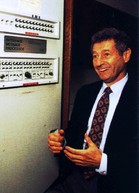-
(b.) - ?1934 June 13
Bio/Description
An American engineer and computer scientist, he is a computer science professor at UCLA's Henry Samueli School of Engineering and Applied Science. He made several important contributions to the field of computer networking; in particular to the theoretical side of computer networking. He also played an important role in the development of the ARPANET, the precursor to the Internet, at UCLA. His most well-known and significant work is his early work on queueing theory, which has applications in many fields, among them as a key mathematical background to packet switching, the basic technology behind the Internet. His initial contribution to this field was his doctoral thesis at the Massachusetts Institute of Technology in 1962, published in book form in 1964; he later published several of the standard works on the subject. He described this work as: "Basically, what I did for my PhD research in 1961?1962 was to establish a mathematical theory of packet networks..." His theoretical work on hierarchical routing, done in the late 1970s with his then-student Farouk Kamoun, is now critical to the operation of today's worldwide Internet. He was born in New York City and graduated from the noted Bronx High School of Science in 1951. He received a Bachelor of Electrical Engineering degree in 1957 from the City College of New York, and a master's degree and a doctorate (Ph.D.) in electrical engineering and computer science from the Massachusetts Institute of Technology in 1959 and 1963 respectively. He then joined the faculty at the University of California at Los Angeles (UCLA), where he remains to the present day; during 1991?1995 he served as the Chairman of the Computer Science Department there. The first message on the ARPANET was sent by UCLA student programmer Charley Kline, at 10:30 p.m, on October 29, 1969 from Boelter Hall 3420. As he supervised, Kline transmitted from the university's SDS Sigma 7 host computer to the Stanford Research Institute's SDS 940 host computer. The message text was the word "login"; the "l" and the "o" letters were transmitted, but the system then crashed. Hence, the literal first message over the ARPANET was "lo". About an hour later, having recovered from the crash, the SDS Sigma 7 computer effected a full "login". The first permanent ARPANET link was established on November 21, 1969, between the IMP at UCLA and the IMP at the Stanford Research Institute. By December 5, 1969, the entire four-node network was established. In 1988, he was the chairman of a group that presented the report Toward a National Research Network to the U.S. Congress. This report was highly influential and was used to develop the High Performance Computing Act of 1991, that was influential in the development of the Internet as it is known today. Funding from the bill was used in the development of the 1993 web browser Mosaic, at the National Center for Supercomputing Applications (NCSA). He has received numerous professional awards ?the prestigious National Medal of Science, the nation's highest scientific honor, from President George W Bush in the White House on September 29, 2008; which proclaimed, "The 2007 National Medal of Science to Leonard Kleinrock for his fundamental contributions to the mathematical theory of modern data networks, and for the functional specification of packet switching, which is the foundation of Internet technology. His mentoring of generations of students has led to the commercialization of technologies that have transformed the world." In 2010 he shared the Dan David Prize.
-
Date of Birth:
1934 June 13 -
Gender:
Male -
Noted For:
Known as a "Father of the Internet” -
Category of Achievement:
-
More Info:


